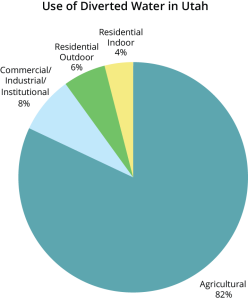Utah’s population is projected to grow by 2.5 million people in the next 35 years. The implications of this projected growth are far reaching for state and local agencies and for policy makers. Previous reports in the 2014 population growth series have discussed where growth will occur, who new Utahns will be, and what they will need to continue to have the quality of life that current Utahns enjoy. This report, the third in a four-part series, focuses on the interaction between population growth and future water supply.
Two different viewpoints 
Since Utah is a desert and water is an essential element of sustaining life, discussions on water policy are not going away. This report presents six recommendations for policy strategies or further study in the fields of rate structure, local response, and planning.
RECOMMENDATIONS
Rate Structure
- Re-examine the role of property tax funding for water agencies, with a goal of reducing tax support and increasing water rates.
- Create more significant price gradations in block-rate water plans.
- Install new technology to monitor water use, such as advanced metering infrastructure (AMI), which provides consumers with real-time feedback on their usage.
Local Response
- State and water conservancy districts should continue to strongly encourage municipal governments to create or update existing ordinances that support conservation.
Planning
- Analyze future needs in a range of population projections and consumption levels.
- Establish better connections between city planning departments and water conservation districts.


Comments:
4 Responses to “Flowing Toward 2050: Utah’s Water Outlook”
Terry Marasco
Stephen, first an inventory. Then report projected new/diminished resources qualified and quantified.
1) Current population, 2)2025, 3) 2050. State without considerations and likely a shortage.
2) Then input considerations (conservation, methodologies, technologies, desal, reuse, reclaim, pricing structures, changes in the law necessary to meet projections, infrastructure needs/improvements, banking, buying, et al).
3) Present this report to the public stating what needs to be done to have water to meet population. Public comments and may also be given an opportunity to vote on whether or not the population should increase.
Lisa
The question is, “Even if Utah pays to develop the Bear River Project and the Lake Powell Pipeline Project water, what will they do when they exhaust those resources?” There seem to be no real plans in place other than “grow more” and “get more.” If, indeed, our leaders are planning for the future, it seems they should be taking truly positive steps now, not just putting off the tough decisions to future generations while they pocket the money from growth right now. Their children and grandchildren may be left with their inherited wealth but they will also be left with bigger problems due to the exacerbated growth that current leaders are encouraging. Utah can continue to grow at reasonable rates with the water currently available without incurring large debts, and that money can be put to more productive use for education and other true “necessities” rather than more golf course in St. George, new homes with large lawns, PUD’s that will not allow their residents to change from lawns to native landscaping, etc. The waste is visible and must change. There has been some change over these last few years, but the growth machine is back in action with little to challenge it.
Anon
Wasn’t this report and all the initial work done by ENVISION UTAH?
Stephen Hershey Kroes
Hello, anonymous poster. Envision Utah was one of many sources on this research. The population growth estimates were done by the Governor’s Office of Management and Budget, and Envision Utah is working on a process of planning for the future based on the estimates and other information they are gathering. We are working with them on several task forces they’ve created as they pursue their Your Utah, Your Future project, so we do discuss these issues with them, but our findings and recommendations are our own.